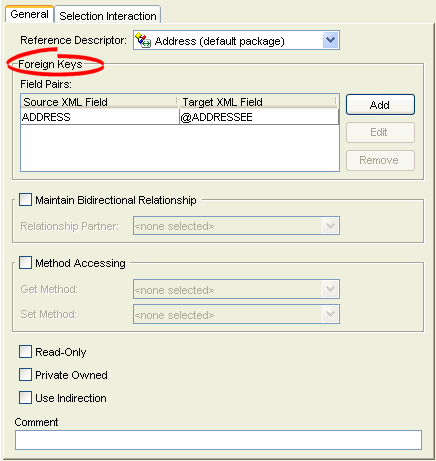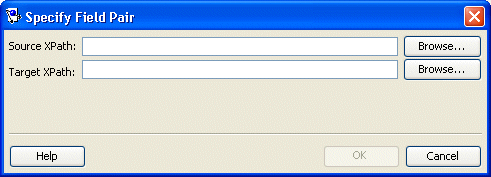| Oracle® TopLink Developer's Guide 10g Release 3 (10.1.3.1.0) Part Number B28218-01 |
|
|
View PDF |
| Oracle® TopLink Developer's Guide 10g Release 3 (10.1.3.1.0) Part Number B28218-01 |
|
|
View PDF |
This chapter describes the various components that you must configure in order to use an EIS one-to-one mapping.
For more information, see the following:
Table 59-1 lists the configurable options for an EIS one-to-one mapping.
Table 59-1 lists the configurable options for an EIS one-to-one mapping.
Table 59-1 Configurable Options for EIS One-to-One Mappings
| Option | Type | TopLink Workbench |
Java |
|---|---|---|---|
|
"Configuring Reference Descriptors" |
Basic |
 |
 |
|
"Configuring Foreign Key Pairs" |
Basic |
 |
 |
|
"Configuring Bidirectional Relationship" |
Advanced |
 |
 |
|
"Configuring Method Accessing" |
Advanced |
 |
 |
|
"Configuring Read-Only Mappings" |
Advanced |
 |
 |
|
"Configuring Private or Independent Relationships" |
Advanced |
 |
 |
|
|
Advanced |
 |
 |
|
"Configuring Mapping Comments" |
Advanced |
 |
 |
|
"Configuring Selection Interaction" |
Basic |
 |
 |
In a one-to-one EIS mapping, you relate a source object attribute to a target object attribute by specifying one or more pairs of source and target object fields.
In a one-to-one EIS mapping with key on source (see "EIS One-to-One Mappings With Key on Source") using XML records, TopLink puts the target XML field value into the source object's record as a simple value.
In a one-to-one EIS mapping with key on target (see "EIS One-to-One Mappings With Key on Target") using XML records, TopLink uses the source XML field value in the selection interaction to acquire the appropriate instance of target object.
To specify the source and target XML field pairs for a one-to-one EIS mapping, use this procedure:
Select the one-to-one EIS mapping in the Navigator. Its properties appear in the Editor.
Click the General tab. The General tab opens.
Figure 59-1 General Tab, Foreign Keys Field

Click Add in the Foreign Keys area to add a key pair. The Specify Field Pair dialog box appears.
Figure 59-2 Specify Field Pair Dialog Box

Click Browse to add a foreign key for the Source XPath and Target XPath fields.